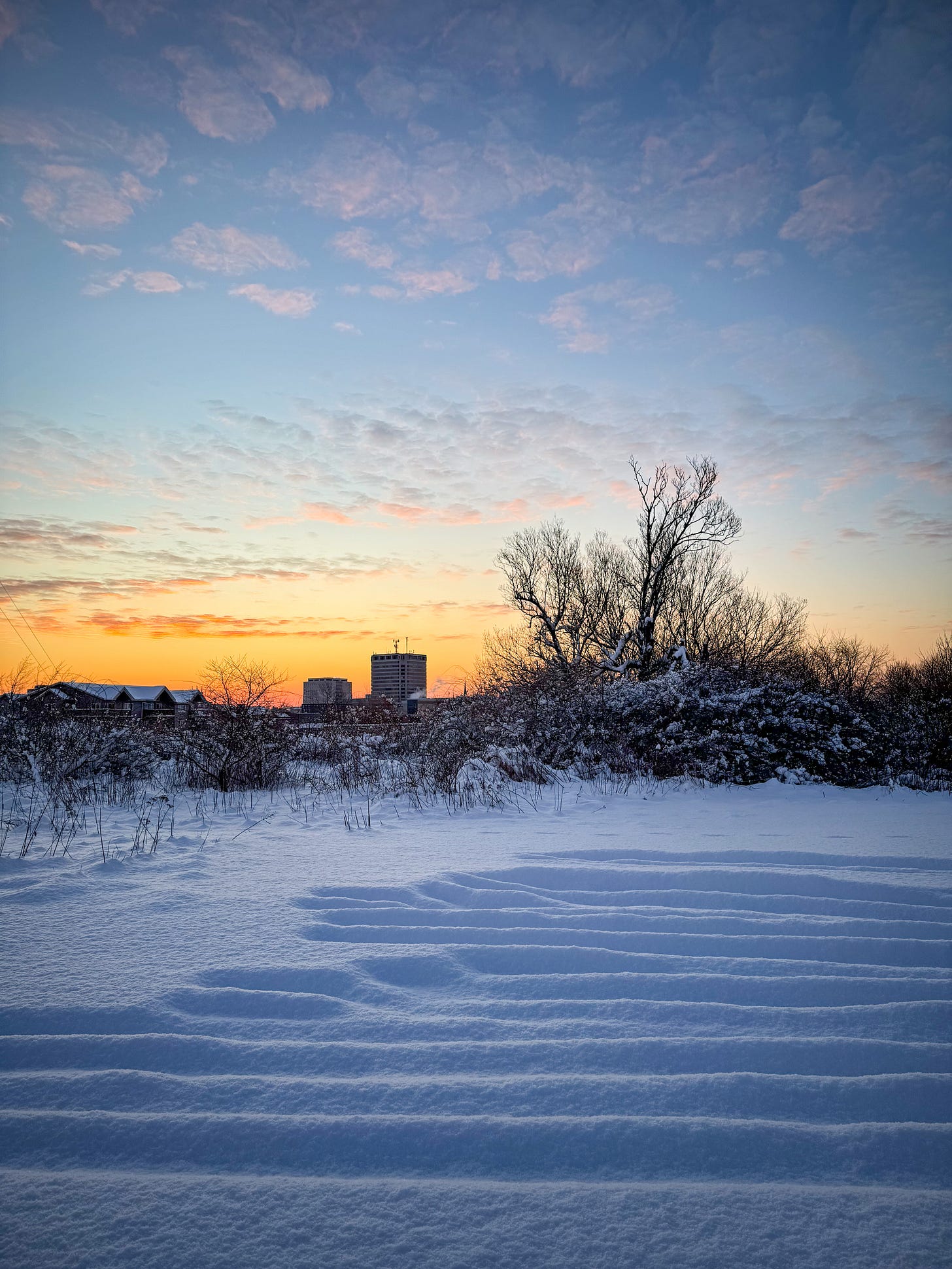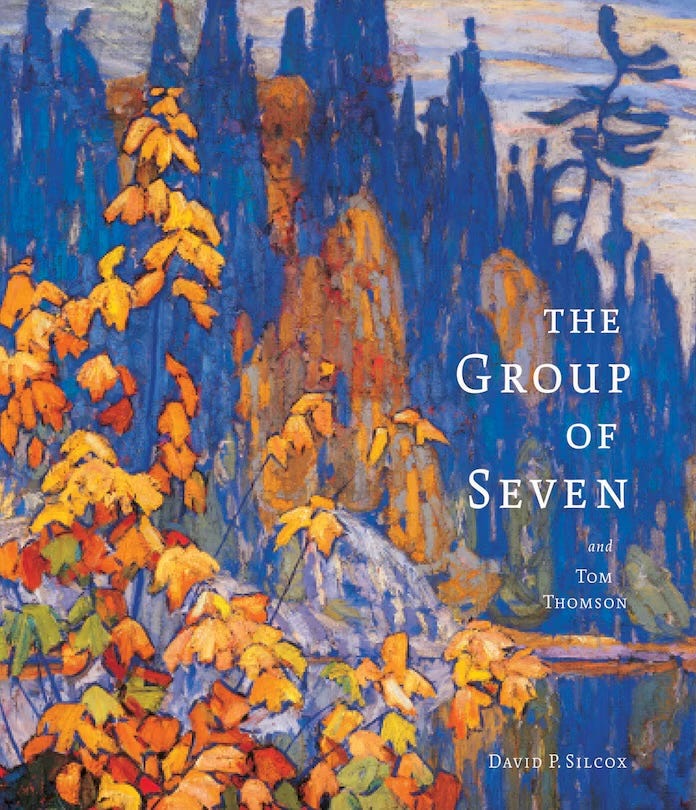It’s cold.
Not the insides-of-your-nostrils freezing, although that might simply be the multiple fleece layers and warm, heavy breath that fills my immediate orbit. Despite the extra steps to enjoying the Great Outdoors (e.g., thin layers that trap heat, woolen winter trimmings for head and hands), I can’t help but be moved to move outside. My motivation is partly due to a need to seize the few opportunities one can have in the winter north of 47°0′; it’s a rare treat lately to snowshoe through fresh powder this far south in the province. The last few winters have been more emblematic of climate woes, with ample bare ground covered in a shell of jagged ice rather than snowy soft forest shapes.
The other need stems from a recent read, in anticipation of an art exhibit visit at the end of January.
The Group of Seven was the self-named collective of early 20th century Canadian painters who sought to create, curate, and promote a unifying artistic identity for the country — one that was distinct from their European forebears and American neighbours, and which captured the essence of “Canadian”1. To do this, the artists in the Group of Seven and their associates, like Tom Thomson, immersed themselves in community and nature to bring life to canvases through a particular style.
After reading about their raison d'être, I was similarly moved to move. After a warm-up loop through a hardwood stand that serves as a biking flow trail, I trek along the Trans Canada trail and the Old Carriage Road before beginning the short, but moderately steep, ascent up my favourite trail in the park. The MacKay Skyway overlooks the Saint John Throughway2 that runs through the city, and provides one of the park’s two views over the industrial heart that beats at the core of Fogtown.
Setting up a snack station at the top of the climb, I take off my snowshoes and prepare the portable camp stove. Ice cubes from a baggie are emptied into the tin to boil. I could have brought a water bottle but it would take too much space; the camera with birding lens took priority.
(I never spy a single creature.)
I pour a sachet of Flash Fuel into the mug and savor the surprisingly palatable and rich tones of the instant camp coffee, as the Sunday morning traffic slowly speeds up. Around me are spruce and fir trees rooted around large, smooth rocks and mosses asleep beneath a sparkling quilt. I’m not sure that I’m getting the same vibe here as the painting masters, or what this scene means for the evolving Canadian identity, but I take a few pictures all the same.
He said, "I'll bring on a brand new renaissance
Because I think I'm ready
When I was shaking all night long
But my hands were steady"

The exhibit room is very dark: The walls are papered in a thick, textured charcoal sheet, and the gallery lights are restrained and stark. A dark sky, against which the Canadian art icon’s works become constellations. We made a point of specifically visiting the gallery to see North Star. In part because we both love nature, but also because it felt like a rare opportunity to view such a large collection of beauty — like catching the perfect, clear night of meteor showers.
The selection of Tom Thomson’s works on display depict his many immersions in the wilderness solo and with the Group of Seven members. On that, a clarifying note: Although associated with the Group of Seven, Thomson was never a formal member of the collective. He died before he could be brought into the fold, at a young age, and unexpectedly, in the heart of his beloved Algonquin Park. (The circumstances of his death pose questions and lend mystery to further his legend; how does an accomplished canoeist and swimmer drown with a head injury, yet his canoe floats him in the lake tied up as if he was readying for portage? Further art is generated to muse on these strange details.)
Slowly, we walk the progression of his works —from the early days of perfectly fine paintings through to the final stunning words of a distinct voice that loved the landscapes that make up Canada. Every few paintings would hold a shift; a new layer of treasure deposit to mark a new period. We pause and peer at thick daubs of paint over still-visible rough board, strokes that give rise to birches, jack pines, large smooths rocks, dead fall, rivers. We stand at a distance and soften our gaze to see the forest for the trees. His visual signature becomes looser over his few years of production, not unlike a child’s tight, bubbly signature to something that gives the impression of words.
The next day, alone while Ben participates in a training session, I return to see what else can be uncovered. What else could inspire an identity in metamorphosis. Strangely, that becomes the theme for the weekend, as we later sit with family to watch the prime minister address the nation.



One often deduces an identity based on what someone is not, allowing the remaining white space to somehow assemble into a coherent and unique pattern. “Not American”; “Not European”; ergo, “Canadian”. What the Group of Seven, and Thomson, did through their work, though, was engage in an active exploration.
This is where I am left now, in the strange days that have followed that snowshoeing adventure and gallery trip and, well, everything else (gesturing at a smouldering Rome). Once we decide what we are not, how can we fill in the remaining white space on the board (and before someone else does it for us)?
I say, bring on a brand new renaissance
Because I think I'm ready
Read More:
A motivation that feels especially salient these days. Of course, some would argue as to the strength of their influence, as well as the idea of unifying under nationalism with a collective voice that was still reflective of a white colonial perspective of the lands.
Not, strangely, the MacKay Highway, which starts a few kilometres later along Route 1.








Thank you for posting this! I'm sorry I couldn't see the North Star exhibition. I love Thompson's work. I actually wrote a short story about his ill-fated canoe trip. Foul play? Maybe. Human? Nope.
These cold days have been hard, and sobering. Thank you for sharing this exhibit! I’ve always loved Tom Thomson. His jack pines inspired my grade 11 art project!